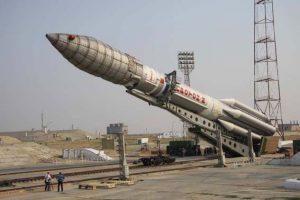
SES announced that the SES-5 satellite roared into space on board an ILS Proton Breeze M booster on 9 July, 2012, from Baikonur. After a nine-hour, 12-minute mission, the Breeze M upper stage of the Proton rocket successfully released the SES-5 satellite directly into geostationary transfer orbit.
The spacecraft, to be positioned at the orbital slot of 5 degrees East, features 36 active Ku-band transponders and up to 24 active C-band transponders
The SES-5 satellite was designed and built for SES by Space Systems/Loral (SS/L). The spacecraft, to be positioned at the orbital slot of 5 degrees East, features 36 active Ku-band transponders and up to 24 active C-band transponders.
SES-5 has two Ku-band beams, one serving customers in the Nordic and Baltic countries and one serving Sub-Saharan Africa, as well as two C-band beams, one with global coverage and one with hemispheric coverage over Europe, Africa and the Middle East. The satellite provides Ka-band uplink capability, allowing for flexible operations between Europe and Africa. SES-5 is reportedly designed to deliver high performance and extensive coverage for Direct-to-Home (DTH) services, broadband, maritime communications, GSM backhaul, and VSAT applications in Europe, Africa and the Middle East.
SES-5 also features the L-band payload for the European Geostationary Navigation Overlay Service (EGNOS). The EGNOS payload, which was developed for the European Commission (EC), will help verify, improve, and report on the reliability and accuracy of navigation positioning signals in Europe.
Romain Bausch, President and CEO of SES, declared: “SES-5 marks the second successful ILS-Proton launch in 2012 for SES and the third SES satellite delivered by Space Systems/Loral in the last ten months. SES-5 furthermore hosts the EGNOS payload for the European Commission. The powerful new satellite enters the global SES fleet as Number 51. ”
European Commission eice-president Antonio Tajani, responsible for industry and Entrepreneurship, said: “This new EGNOS launch demonstrates the commission’s commitment to providing positioning signals with the highest possible accuracy to citizens and businesses in Europe. This opens up a multitude of business opportunities, today and in the future, especially when EGNOS will start working with Galileo when Galileo becomes operational in 2014.”
Frank McKenna, president of ILS, said: “ILS and SES have a partnership that spans 16 years, starting with the very first ILS Proton launch with SES’ Astra 1F satellite. Since that time, ILS Proton has launched 21 of SES’ satellites, which provide telecommunications services for their diverse customer base across the globe.”
John Celli, president of Space Systems/Loral, stated: “It has been a privilege to work with SES on this complex, multi-mission satellite. SES-5 demonstrates the robust capability of the 1300 platform to provide state-of-the-art communications and at the same time host an important payload for the European Commission. Congratulations to everyone at launch base for their hard work and particularly to the teams from ILS, Khrunichev, and SES on another very successful launch.”














Add Comment